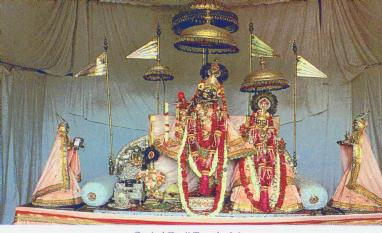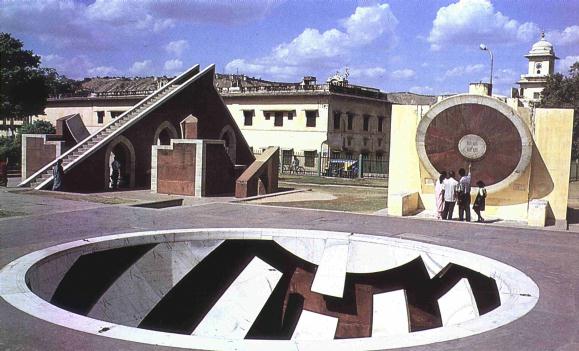

Jaipur, popularly known as the Pink City, was founded in 1727 AD by one of the greatest rulers of the Kachhawaha clan, the astronomer king Sawai Jai Singh. The pink color was used at the time of making to create an impression of red sandstone buildings of Mughal cities - and repainted in 1876, during the visit of the Prince of Wales. The city is best explored on foot and the adventurous visitor willing to go into the inner lanes can discover a whole new world not visible to the tourist-in-a-hurry.

Places of interest are mainly located within the walled city.
 |
Sawai Jai Singh's Chandra Mahal (Moon Palace), better known as the City Palace, is the official residence of the royal family. The royal family still lives in a portion of this palace, while the outer courtyards and the ground floor halls have been converted into the Maharaja Sawai Man Singh II Museum that is open to public. The City Palace complex is the most important landmark with its numerous outbuildings, courtyards, impressive gateways and temples. The museum houses an extensive collection of rare manuscripts, Mughal and rajasthani miniatures, mughal carpets, costumes and textiles, arms and weapons and royal paraphernalia.
 |
 |
Across the road from the palace is the Jantar Mantar, one of the five observatories built by Sawai Jai Singh. A collection of complex astronomical instruments, chisseled out of stone- most of which continue to provide fairly accurate information to this day - is the highlight of this observatory
 |
Hawa Mahal (Palace of Winds) adjoins the outside of the palace wall. Built in 1799 by Maharaja Sawai Pratap Singh, the Hawa Mahal is a remarkable structure which overlooks one of the main streets and also provides some excellent views of the city. In the not-too-distant past, ladies of the court found it convenient to watch the activities on the streets below without being observed themselves.
Located just outside the walled city is the sprawling Ram Niwas Garden. The garden houses the majestic Albert Hall Mueseum. Opened in 1887 AD, this impressive building displays a rich collection of paintings, carpets, ivory, stone and metal sculpture among other objects.
 |
Set in a picturesque location, Amer is a fascinating blend of Hindu and Mughal architecture. Built in the 16th century by Raja Man Singh, it sprawls on the hillside. Here you see a panoramic view of the formidable Amer with Jaigarh in the background. Built in red sandstone and white marble, the palace complex has some very interesting apartments, the likes of which are not to be found anywhere else in the country. Jai Mandir, Sheesh Mahal, Sukh Niwas and Ganesh Pole are the prominent areas of interest.
The old township of Amer lies at the foothills of the palace and has an old world charm, a character of its own. Jagat Shiromani Temple, Narsingh Temple are some of the places of interest.
Jaigarh , or the Fort of Victory, is a rugged fort built in 1726. The world's largest cannon on wheels is to be found here. The fort houses a museum and provides some excellent views of the Amer Palace.
It is the first of the three forts. Built in 1734, this fort provides some stunning views of the city down below both during daytime and at night. An open air restaurant-"PADAO" lets you enjoy the panoramic view of the city even as you sip a hot cup of coffee on a pleasant evening!

A picturesque palace amidst the Man Sagar Lake. It was built for royal duck shooting parties. A great place to visit during the monsoons.
A newly restored temple on the foothills of Nahargarh. The landscaped gardens have made it a popular picnic spot.
A pilgrimage center with several pavilions, natural sprins and the only sun temple in this part of India.
On the way to Galta, these gardens are laid out in tiers. These house several galleries, pavilions and beautiful murals depicting scenes from the life of Lord Krishna which are a visual delight. An ideal location for watching peacocks.
The old palace, renovated and rebuilt in the 19th century provides one of the most gorgeously decorated and painted examples of Rajput haveli architecture. Located 40 km northwest of Jaipur, amidst the quiet of protective hills,this palace is a visual treat. The sleepy little town of Samod has its own cloth printers, bangle makers and other artisans. The palace has recently been converted as a heritage hotel.

Jaipur is a shopper's paradise. This is one of the few places where the shoppers may actually watch the skilled artisans producing the articles they want to buy.
For more information on what and where to shop in Jaipur, click here.

